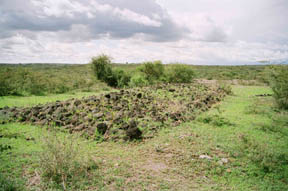Laetoli
Laetoli is a site in Tanzania, located in the Ngorongoro Conservation Area, that has been instrumental in understanding human evolution. The site gained international attention in the late 20th century following the discovery of ancient hominin footprints preserved in volcanic ash. These footprints, attributed to Australopithecus afarensis, are significant for providing evidence of bipedalism in early human ancestors approximately 3.6 million years ago. The Laetoli footprints were discovered in 1978 by a team led by Mary Leakey, a renowned paleoanthropologist. The site consists of two main fossilized footprint trails, known as G1 and G2, along with a smaller trail, G3, which were left by three individual hominins. The preservation of these footprints was a result of volcanic ash from a nearby volcano, which solidified and later was uncovered by erosion. In addition to the footprints, Laetoli is also known for its fossilized remains of flora and fauna, providing valuable insights into the environment of the Pliocene epoch. The site has yielded numerous fossils of early human ancestors, animals, and plant life, contributing to our understanding of the ecosystem in which early hominins lived. The discovery of the Laetoli footprints has had a profound impact on the study of human evolution, offering concrete evidence of bipedal locomotion in early hominins. This finding supports the hypothesis that bipedalism preceded the development of large brains in human evolution. Laetoli continues to be an important site for paleoanthropological research, with ongoing excavations and studies aimed at uncovering more about our early ancestors and their environment. The site's significance extends beyond the scientific community, contributing to discussions on human origins and our connection to the natural world.
Search WikiMD
Ad.Tired of being Overweight? Try W8MD's physician weight loss program.
Semaglutide (Ozempic / Wegovy and Tirzepatide (Mounjaro / Zepbound) available.
Advertise on WikiMD
|
WikiMD's Wellness Encyclopedia |
| Let Food Be Thy Medicine Medicine Thy Food - Hippocrates |
Translate this page: - East Asian
中文,
日本,
한국어,
South Asian
हिन्दी,
தமிழ்,
తెలుగు,
Urdu,
ಕನ್ನಡ,
Southeast Asian
Indonesian,
Vietnamese,
Thai,
မြန်မာဘာသာ,
বাংলা
European
español,
Deutsch,
français,
Greek,
português do Brasil,
polski,
română,
русский,
Nederlands,
norsk,
svenska,
suomi,
Italian
Middle Eastern & African
عربى,
Turkish,
Persian,
Hebrew,
Afrikaans,
isiZulu,
Kiswahili,
Other
Bulgarian,
Hungarian,
Czech,
Swedish,
മലയാളം,
मराठी,
ਪੰਜਾਬੀ,
ગુજરાતી,
Portuguese,
Ukrainian
Medical Disclaimer: WikiMD is not a substitute for professional medical advice. The information on WikiMD is provided as an information resource only, may be incorrect, outdated or misleading, and is not to be used or relied on for any diagnostic or treatment purposes. Please consult your health care provider before making any healthcare decisions or for guidance about a specific medical condition. WikiMD expressly disclaims responsibility, and shall have no liability, for any damages, loss, injury, or liability whatsoever suffered as a result of your reliance on the information contained in this site. By visiting this site you agree to the foregoing terms and conditions, which may from time to time be changed or supplemented by WikiMD. If you do not agree to the foregoing terms and conditions, you should not enter or use this site. See full disclaimer.
Credits:Most images are courtesy of Wikimedia commons, and templates Wikipedia, licensed under CC BY SA or similar.
Contributors: Prab R. Tumpati, MD

